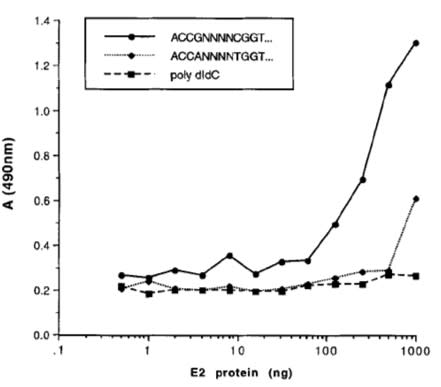Cat. #151168
Anti-HPV16E2 [TVG 271]
Cat. #: 151168
Sub-type: Primary antibody
Unit size: 100 ug
Availability: 3-4 weeks
Target: Human Papilloma virus-16 early protein 2 (HPV16 E2)
Class: Monoclonal
Application: ELISA ; WB ; ELISA ; WB
Reactivity: Human papilloma virus
Host: Mouse
£300.00
This fee is applicable only for non-profit organisations. If you are a for-profit organisation or a researcher working on commercially-sponsored academic research, you will need to contact our licensing team for a commercial use license.
Contributor
Inventor: Lionel Crawford
Institute: University of Cambridge
Tool Details
*FOR RESEARCH USE ONLY (for other uses, please contact the licensing team)
- Name: Anti-HPV16E2 [TVG 271]
- Cancer: Gynaecologic cancer
- Cancers detailed: Cervical
- Research fields: Cancer;Microbiology
- Clone: TVG 271
- Tool sub type: Primary antibody
- Class: Monoclonal
- Conjugation: Unconjugated
- Strain: Balb/c
- Reactivity: Human papilloma virus
- Host: Mouse
- Application: ELISA ; WB ; ELISA ; WB
- Description: TVG 271 is useful for detection of protein in cervical lesions. TVG 271 completely inhibits E2 binding to E1.
- Immunogen: Maltose binding protein MBP-E2 (generated from an expression vector in which the E2 ORF was cloned in frame with malE)
- Isotype: IgG1
- Myeloma used: P3/NS1/1-Ag4.1
Target Details
- Target: Human Papilloma virus-16 early protein 2 (HPV16 E2)
- Target background: The human papilloma virus (HPV) family of DNA tumor viruses includes HPV-16 and HPV-18, which are associated with a large proportion of cervical cancer cases. E1 and E2 are proteins involved in the regulation of viral DNA replication.
Applications
- Application: ELISA ; WB ; ELISA ; WB
Handling
- Format: Liquid
- Concentration: 1 mg/ml
- Unit size: 100 ug
- Storage buffer: PBS with 0.02% azide
- Storage conditions: '-15° C to -25° C
- Shipping conditions: Dry ice
References
- Hibma et al. 1995. Eur J Biochem. 229(2):517-25. PMID: 7744075.





